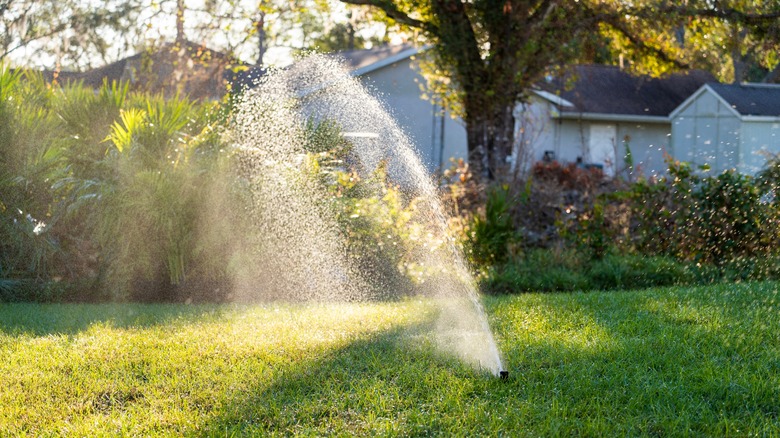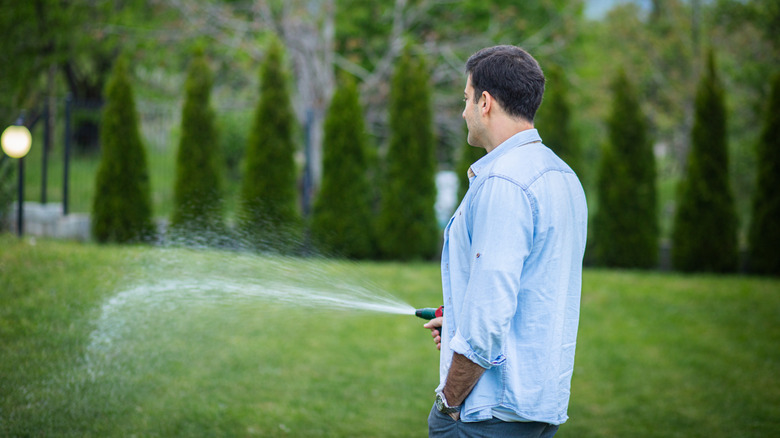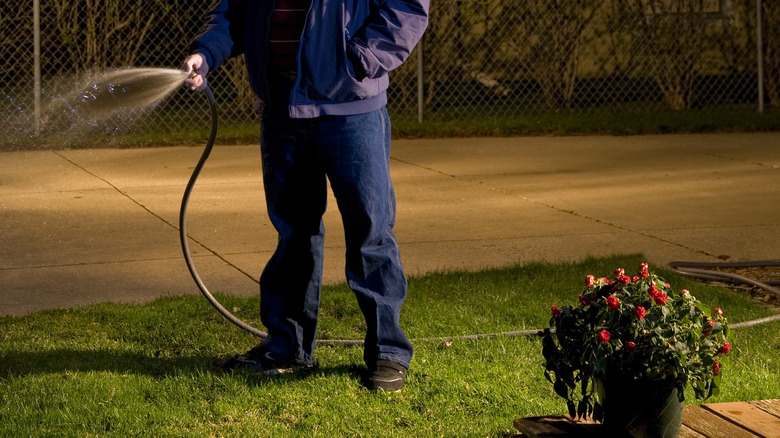The Best Time Of Day To Water A Lawn For Healthy, Green Grass
Watering a lawn properly is key if you want to keep your grass looking healthy and lush. But despite your efforts to get it right, it's easy to water too much or not enough. Even if you have an automated irrigation system, you still need to step in now and then to adjust the schedule based on the climate. For example, in an unusually rainy month, you will need to skip some of your normal irrigation sessions. But if the next month is unusually dry or hot, you might need to add a couple of extra watering sessions to keep your lawn from drying out.
One of the biggest mistakes everyone makes when watering their lawn, however, is watering at the wrong time of day. To minimize the amount of water lost to evaporation and prevent fungal diseases, the best time of day to water your lawn is between about 5:00 a.m. and 9:00 a.m.
However, it's not always practical for every gardener to water their lawn early in the morning, especially if they don't have an automated sprinkler system to do it for them. So if you can't water early, you'll need to adapt your irrigation routine to compensate for the risks of watering later in the day. Here's why morning watering is the best option for your lawn and what to do if you can't water your lawn that early.
How to maximize the benefits of early morning irrigation
The early morning hours, between roughly 5:00 a.m. and 9:00 a.m., are when temperatures are cooler and winds are calmer. That makes it the ideal time to make the most of your lawn irrigation system because most of the water applied actually soaks into the soil. It also improves the odds of evenly watering your entire lawn, since there's less chance of strong winds blowing water so that some patches are oversaturated while others don't get enough water. Lastly, this time frame is still close enough to daytime that your grass won't sit wet any longer than necessary, which can help decrease the risk of diseases spreading through your lawn.
However, the exact time depends on your climate and the time of year. Your goal is to find that window when the sun hasn't dried out the dew on the ground yet, so the risk of water evaporation is low, but it's not so early that your grass will be sitting wet for hours before the sun and wind later in the day can dry them off.
For gardeners in cooler climates or during the cooler months of spring and fall, that might mean waiting until closer to 9:00 a.m. or even later. Meanwhile, those in hotter climates or during the hottest weeks of summer might need to shift their schedule closer to 5:00 a.m. because the dew on the ground is already dried up long before 9:00 a.m. Regardless of where you are, you may want to adjust your timing throughout the growing season to account for the shifting temperatures and daylight through spring, summer, and fall.
What to do if you can't water your lawn early enough
While early morning is ideal, it's not always practical. If you don't have an automated system and you're too busy in the morning to take time out for the lawn, all is not lost. The second-best time to water is at night, after about 8:00 p.m. Nighttime watering still gives you the advantage of less evaporation, with as much as 50% less water loss compared to daytime.
However, letting the grass sit wet all night long may increase the risk of disease. To minimize that risk, it's even more important to water deeply but infrequently if watering at night. Give your lawn all the water it needs for the week in a single application so that the grass is dry for the rest of the week. It also helps to store your hose in a shed or shaded area to avoid watering your lawn with hot water that's been heating up all day.
The hottest part of the day is between about 10:00 a.m. and 4:00 p.m. This is when you'll lose the most water to evaporation — as much as 30%, depending on wind, temperature, and humidity that day. If you absolutely must water during those hours, remember to increase your irrigation to account for evaporation. At 30% loss, your lawn is getting only about 0.7 inches for every 1 inch of water you apply. So you'd need to apply nearly 1.5 inches of water to ensure that at least 1 inch actually soaks into your soil.


